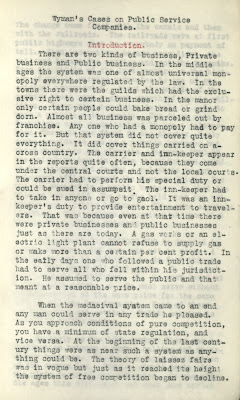The Riesenfeld Center has recently acquired a series of rare and important titles connected to the history of legal education and the profession. The books were added to the collection through a generous donation by William Lindberg ('73), who served for many years as an executive at West Publishing Company in St. Paul, on both the print and electronic sides of its product line. The Riesenfeld Center is deeply grateful for Mr. Lindberg's generous and thoughtful gift, which benefits the rare books collection in a direct way, through the acquisition of historically significant titles of permanent value.
Several of the newly acquired titles shed light directly on legal education as it developed in nineteenth- and twentieth-century America. Two are extensive notebooks from the collection of Byron Coleman, a prominent San Francisco attorney. The bound notebooks, underlining aspects of Coleman's legal education at Harvard in 1912 and 1913, are carefully typewritten
in red and black, composed of more than 1800 pages analyzing cases and
principles. Among the casebooks that
Coleman studied and heard lectures on were those of famous faculty James
Barr Ames (equity and trusts), John Chipman Gray (property), James
Bradley Thayer (evidence), and Samuel Williston (sales). Coleman
digested each case in preparation for class and exams. Notes from class discussions of the
cases are recorded below the initial case summaries. The
case method of instruction, pioneered in the 1870s by Christopher Columbus Langdell at Harvard and adopted generally in American law school curricula, is
readily apparent in the volumes. Though not followed immediately, the case method took its place at Harvard and schools across the country by the early 20th century. Coleman also usefully recorded the dissenting and parenthetical
commentary of his teachers, who included cases that were instructive but
not necessarily (in their view) rightly decided. The notes offer
fascinating insight into a formative period of American legal education, adding early discussions of landmark cases.
Other American legal titles among the acquisitions are also notable. Two in particular form a neat pair. Simon Greenleaf's Discourse Pronounced at the Inauguration of the Author as Royall Professor of Law in Harvard University (1834), signed by the author, provides Greenleaf's vision, as a newly-appointed Harvard law professor, of American legal education as it was
developing within universities; and he outlines the leading role Harvard was to play
in American legal education. Greenleaf was named to the Royall professorship at Harvard Law School in 1833, remaining there until 1848. An influential faculty member during the school's early days, Greenleaf penned the leading American treatise on evidence in the nineteenth century. Another title from the same period, Samuel Atkinson's Catechism of American Law: Adapted to Popular Use (1832) appears to follow the question-and-answer format of Martin Luther’s Small Catechism, dividing American law into familiar topics, including marriage, contracts, property, partnership, and insurance, which would be useful for laymen and introductory students. At a time when self-study and apprenticeship were common – and when legal literacy was important in a burgeoning mercantile society – the author Atkinson attempted to meet a public need. Each work offers a different and valuable perspective on legal education during a period of American growth in which there was enduring uncertainty over how best to learn and train in the law.
Among acquisitions on English legal education, volumes treat the role and value of forensic argument, the issue of religious tolerance in schools, and the reform of legal education in eighteenth- and nineteenth-century England. Two items, Tutor and Pupils (London, 1891) and Letters to John Bull on Lawyers and Law Reform (London, 1857), reflect entrenched approaches, alongside efforts to modernize legal education in nineteenth-century England, at a time when American legal education began to break its own path. Taken together, the works show an evolving tradition in both countries, whose systems remained intertwined.
- Ryan Greenwood, Curator of Rare Books and Special Collections


